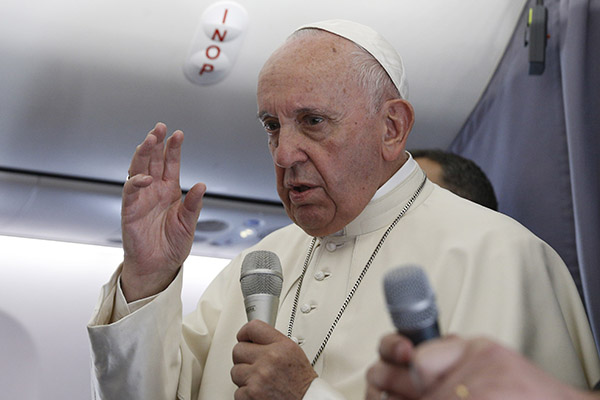
By John L. Allen
ROME (Crux) – Under the heading of “trade secrets” in Vaticanology, here’s something everyone who covers the place knows but doesn’t usually say out loud: A large part of the reason news organizations are willing to pay the exorbitant costs of traveling aboard the papal plane with Pope Francis has nothing to do with the trip itself – it’s about the press conference at the end.
Since that magical first trip in July 2013, when, on the way back from Rio de Janeiro for World Youth Day, Pope Francis gave us the immortal “Who am I to judge?” soundbite on gay clergy, reporters and editors have seen the possibility of another such thunderclap as worth it to be on the plane, even if the outing itself doesn’t necessarily have much sex appeal.
For the most part, the Holy Father has delivered good return on that investment.
From quipping that Catholics aren’t obliged to “breed like rabbits” during a return flight from the Philippines in 2015, to – more or less – suggesting that then-candidate Donald Trump was “not a Christian” for his pledge to build a border wall with Mexico in 2016, the Argentine pontiff routinely has provided front-page material.
Of late, however, these in-flight news conferences have been considerably less spicy, often serving up little more than reiterations of things Pope Francis already has said, or excuses to allow the pope to say things that he or his advisers want on the record for one reason or another.
Sunday’s brief encounter with the press coming back from a three-day swing in Romania was a good case in point.
First, in part because of the brief duration of the flight, it was short – just about a half-hour bell to bell. Moreover, the first few minutes were eaten up by the pontiff’s spokesman, Italian layman Alessandro Gisotti, inexplicably asking the pope to offer a reflection on the World Day of Social Communications.
(Perhaps, though, it’s not inexplicable at all, given that every minute the pope is talking about something else is a minute he’s not answering serious questions.)
Next up were two questions from the local press in Romania, which is tradition in these settings. That left space for just four questions from the world’s press, which were devoted to the following subjects:
- Catholic/Orthodox relations, including the difficulties of joint prayer.
- A recent electoral victory by Matteo Salvini, Italy’s anti-immigrant Deputy Prime Minister, and whether Pope Francis will meet Salvini.
- Pope Francis’s relationship with Pope emeritus Benedict XVI.
- The future of Europe.
For the Europeans, the big headline was Pope Francis’s appeal for unity, which of course comes at a time when the EU in some ways appears to be disintegrating under a wave of populist resentments. For everyone else, it was him saying that Pope emeritus Benedict gives him “strength” and represents the “sap of our roots,” which flies in the face of the popular narrative that Pope emeritus Benedict and Pope Francis are somehow at odds.
What’s the problem? Well, the press conference was basically a classic case of the dog that didn’t bark.
In the week leading up to the trip, there was a clear winner for biggest Vatican story: A double-barreled combination of Pope Francis saying he knew “nothing, nothing” about sexual misconduct and abuse charges against ex-Cardinal Theodore McCarrick, combined with revelations of correspondence from an ex-aide to McCarrick confirming that Vatican restrictions had been imposed in 2008 and were progressively ignored.
The obvious question was something like: “Last October, you pledged a ‘thorough study’ of the McCarrick case. Especially in light of this week’s news, when can we expect the results, and, based on its results, will anyone be held accountable for failure to act?”
English-speaking journalists aboard the plane were planning to ask something along those lines, but the plug was pulled before it was their turn. In all fairness, English-speakers got a turn during the last trip to Bulgaria and Macedonia, but that doesn’t really quite explain it.
Here’s the thing: Such a question was the most foreseeable thing in the world, as was the fact that any news conference would be considered a disappointment – by some, even, a sham – if it wasn’t asked and answered. By calling a halt before it came up, the only possible conclusion many observers can draw is that the pope himself, or his Vatican team, or both, didn’t want to talk about it.
To be clear, these flights are basically the only time the pontiff meets the press in such a fashion. It’s not as if the McCarrick business can be handled during his monthly news conference in Rome, because such a thing doesn’t exist.
From the very beginning, a large part of the charisma Pope Francis exudes has been about his spontaneity and openness. He’s been a pope who encourages debate, willing to tackle hard questions in public settings. Whether one always likes his answers or not, the mere fact Francis shares them has been hugely to his credit.
Increasingly, however, there’s a sense that the pontiff and his advisers are becoming more restrained, sometimes trying to avoid putting him in a position where that spontaneity might once again be triggered.
If so, and if it continues, it might come at a cost – and not just because news outlets might find themselves dubious about footing the costs of papal travel.
The real problem is that it might create impressions of an administration with something to hide, even if the administration in question isn’t just that of Pope Francis but those of St. Pope John Paul II and Pope emeritus Benedict XVI, on whose watches McCarrick’s career was really shaped. Whatever the case, the reform Pope Francis has pledged rests in part on transparency – and declining to even engage an obvious question likely will strike many people as a bit less than transparent.
